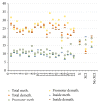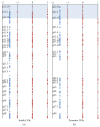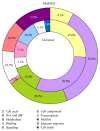The Effect of Culture on Human Bone Marrow Mesenchymal Stem Cells: Focus on DNA Methylation Profiles
- PMID: 26880970
- PMCID: PMC4736560
- DOI: 10.1155/2016/5656701
The Effect of Culture on Human Bone Marrow Mesenchymal Stem Cells: Focus on DNA Methylation Profiles
Abstract
Human bone marrow mesenchymal stem cells (hBM-MSCs) are the best characterized multipotent adult stem cells. Their self-renewal capacity, multilineage differentiation potential, and immunomodulatory properties have indicated that they can be used in many clinical therapies. In a previous work we studied the DNA methylation levels of hBM-MSC genomic DNA in order to delineate a kind of methylation signature specific for early and late passages of culture. In the present work we focused on the modification of the methylation profiles of the X chromosome and imprinted loci, as sites expected to be more stable than whole genome. We propose a model where cultured hBM-MSCs undergo random modifications at the methylation level of most CGIs, nevertheless reflecting the original methylation status. We also pointed out global genome-wide demethylation connected to the long-term culture and senescence. Modification at CGIs promoters of specific genes could be related to the decrease in adipogenic differentiation potential. In conclusion, we showed important changes in CGIs methylation due to long-term in vitro culture that may affect the differentiation potential of hBM-MSCs. Therefore it is necessary to optimize the experimental conditions for in vitro expansion in order to minimize these epigenetic changes and to standardize safer procedures.
Figures



Similar articles
-
From cytogenomic to epigenomic profiles: monitoring the biologic behavior of in vitro cultured human bone marrow mesenchymal stem cells.Stem Cell Res Ther. 2012 Nov 20;3(6):47. doi: 10.1186/scrt138. Stem Cell Res Ther. 2012. PMID: 23168092 Free PMC article.
-
Histone Arginine Methylation-Mediated Epigenetic Regulation of Discoidin Domain Receptor 2 Controls the Senescence of Human Bone Marrow Mesenchymal Stem Cells.Stem Cells Int. 2019 Jul 11;2019:7670316. doi: 10.1155/2019/7670316. eCollection 2019. Stem Cells Int. 2019. PMID: 31379950 Free PMC article.
-
Identity, proliferation capacity, genomic stability and novel senescence markers of mesenchymal stem cells isolated from low volume of human bone marrow.Oncotarget. 2016 Mar 8;7(10):10788-802. doi: 10.18632/oncotarget.7456. Oncotarget. 2016. PMID: 26910916 Free PMC article.
-
DNA methylation and demethylation link the properties of mesenchymal stem cells: Regeneration and immunomodulation.World J Stem Cells. 2020 May 26;12(5):351-358. doi: 10.4252/wjsc.v12.i5.351. World J Stem Cells. 2020. PMID: 32547683 Free PMC article. Review.
-
From bone marrow to therapeutic applications: different behaviour and genetic/epigenetic stability during mesenchymal stem cell expansion in autologous and foetal bovine sera?Int J Dev Biol. 2008;52(8):1023-32. doi: 10.1387/ijdb.082725gt. Int J Dev Biol. 2008. PMID: 18956335 Review.
Cited by
-
Mitochondrial Functional Changes Characterization in Young and Senescent Human Adipose Derived MSCs.Front Aging Neurosci. 2016 Dec 15;8:299. doi: 10.3389/fnagi.2016.00299. eCollection 2016. Front Aging Neurosci. 2016. PMID: 28018212 Free PMC article.
-
Strategy for the Generation of Engineered Bone Constructs Based on Umbilical Cord Mesenchymal Stromal Cells Expanded with Human Platelet Lysate.Stem Cells Int. 2019 Dec 1;2019:7198215. doi: 10.1155/2019/7198215. eCollection 2019. Stem Cells Int. 2019. PMID: 31885622 Free PMC article.
-
Craniofacial Bone Tissue Engineering: Current Approaches and Potential Therapy.Cells. 2021 Nov 3;10(11):2993. doi: 10.3390/cells10112993. Cells. 2021. PMID: 34831216 Free PMC article. Review.
-
Epigenetic Regulation in Mesenchymal Stem Cell Aging and Differentiation and Osteoporosis.Stem Cells Int. 2020 Sep 10;2020:8836258. doi: 10.1155/2020/8836258. eCollection 2020. Stem Cells Int. 2020. PMID: 32963550 Free PMC article. Review.
-
Effects of Systemic or Local Administration of Mesenchymal Stem Cells from Patients with Osteoporosis or Osteoarthritis on Femoral Fracture Healing in a Mouse Model.Biomolecules. 2022 May 19;12(5):722. doi: 10.3390/biom12050722. Biomolecules. 2022. PMID: 35625649 Free PMC article.
References
-
- Kim M., Kim C., Choi Y. S., Kim M., Park C., Suh Y. Age-related alterations in mesenchymal stem cells related to shift in differentiation from osteogenic to adipogenic potential: implication to age-associated bone diseases and defects. Mechanisms of Ageing and Development. 2012;133(5):215–225. doi: 10.1016/j.mad.2012.03.014. - DOI - PubMed
LinkOut - more resources
Full Text Sources
Other Literature Sources

